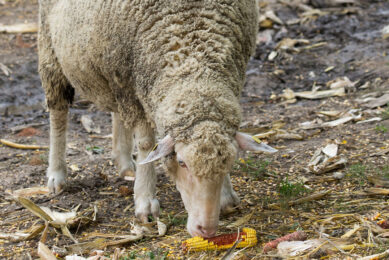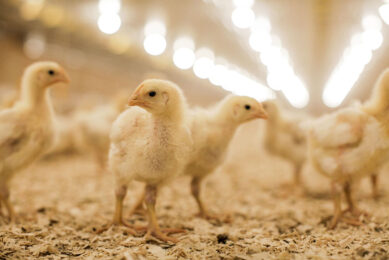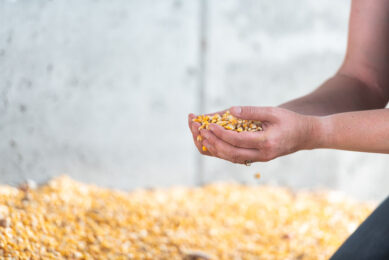Many challenges for Slovenian food producers
Like many feed companies around the world, Jata Emona, Slovenian’s leading feed company, faces increasing raw material costs. Stojan Hergouth, general manager of the company, spoke to Feed Tech about how he deals with this major challenge. By Philippe Caldier
Overview of a Jata Emona plant in Ljubljana
Jata Emona consists of a group of feed plants with a total annual
production of around 210,000 tonnes, which is almost half of Slovenia’s total
feed production. The company became a leader in the feed market after three
acquisitions in 2001. They bought a commercial feed mill with a production
capacity of 20,000 tonnes, a poultry feed mill with a production of 35,000
tonnes, as well as a premix unit. Thanks to these acquisitions, Jata Emona is
present all over the country and can therefore better cope with international
competition. “Our competitors are Austrian and Italian,” explains Hergouth.
However, he says to be the market leader is not enough in Slovenia. “We have to
keep on strengthening our business as we will face many challenges in the
future.”
production of around 210,000 tonnes, which is almost half of Slovenia’s total
feed production. The company became a leader in the feed market after three
acquisitions in 2001. They bought a commercial feed mill with a production
capacity of 20,000 tonnes, a poultry feed mill with a production of 35,000
tonnes, as well as a premix unit. Thanks to these acquisitions, Jata Emona is
present all over the country and can therefore better cope with international
competition. “Our competitors are Austrian and Italian,” explains Hergouth.
However, he says to be the market leader is not enough in Slovenia. “We have to
keep on strengthening our business as we will face many challenges in the
future.”
Raw material prices
One of
Hergouth’s main concerns is the continuous increase in the price of raw
materials. He, like many in the feed industry, hopes that a time will come when
the price will once again stabilise. The price of barley jumped from
€96-97/tonne in 2006, to €150-155/tonne in 2007. This forced the company to
increase its feed prices, for the first time, in October 2006. Dairy feed, for
example (the most typical one pelleted in bulk), jumped from €0.17/kg in
February 2006, to €0.20 on July 1, 2007. Pressure on raw materials may continue
further as Hungary has just built a big bioethanol plant in the south of the
country. “The cheapest corn in Hungary today is €138-140/tonne instead of €89
per tonne in 2002,” says Hergouth. For him, the only solution is to transfer
this increase of raw material prices to the producers.
One of
Hergouth’s main concerns is the continuous increase in the price of raw
materials. He, like many in the feed industry, hopes that a time will come when
the price will once again stabilise. The price of barley jumped from
€96-97/tonne in 2006, to €150-155/tonne in 2007. This forced the company to
increase its feed prices, for the first time, in October 2006. Dairy feed, for
example (the most typical one pelleted in bulk), jumped from €0.17/kg in
February 2006, to €0.20 on July 1, 2007. Pressure on raw materials may continue
further as Hungary has just built a big bioethanol plant in the south of the
country. “The cheapest corn in Hungary today is €138-140/tonne instead of €89
per tonne in 2002,” says Hergouth. For him, the only solution is to transfer
this increase of raw material prices to the producers.
Increase number of cattle farms
The
increasing raw material costs are not the only difficulty that needs to be dealt
with, but also the average farm size in Slovenia. According to 2005 figures from
the Slovenian Chamber of agriculture, Slovenian farms had an average of 5.5
livestock units and 14.9 pigs. “Slovenian farmers are far from specialised,”
says Nataša Belingar, director of the Chamber. In addition, 57% of Slovenian
farmers are more than 58 years old. Today, most young farmers are interested in cattle production,
most young farmers are interested in cattle production,
which is encouraged by the Chamber. The increase in the number of cattle farms
is welcomed by feed company Jata Emona. “Most farms with more than 100 cows are
clients of our company. These farmers are curious of new techniques and new
products, and it is for this reason that we continually try to improve our
services,” explains Hergouth. The cattle feed market in Slovenia is the second
largest behind poultry feed. However, it is the only segment that has
experienced continual growth over the last 10 years, partly due to the
improvement of dairy yields. In 10 years, average lactation increased from 5,000
to 7,500 litres, which resulted in an increase in cattle feed production from
45,000 tonnes to 122,000 tonnes.
The
increasing raw material costs are not the only difficulty that needs to be dealt
with, but also the average farm size in Slovenia. According to 2005 figures from
the Slovenian Chamber of agriculture, Slovenian farms had an average of 5.5
livestock units and 14.9 pigs. “Slovenian farmers are far from specialised,”
says Nataša Belingar, director of the Chamber. In addition, 57% of Slovenian
farmers are more than 58 years old. Today,
which is encouraged by the Chamber. The increase in the number of cattle farms
is welcomed by feed company Jata Emona. “Most farms with more than 100 cows are
clients of our company. These farmers are curious of new techniques and new
products, and it is for this reason that we continually try to improve our
services,” explains Hergouth. The cattle feed market in Slovenia is the second
largest behind poultry feed. However, it is the only segment that has
experienced continual growth over the last 10 years, partly due to the
improvement of dairy yields. In 10 years, average lactation increased from 5,000
to 7,500 litres, which resulted in an increase in cattle feed production from
45,000 tonnes to 122,000 tonnes.
Dejan Zidan (Panvita):
“We want to offer the best meat quality”
Organic selenium supplementation trials
Founded in 1922, Panvita is a group of 12 different
companies involved in food production, primarily pigs (120-130,000 pigs/year).
“We have two big pig farms in the Pomoria region, which is located in northeast
of Slovenia, in a region covering 42% of the Slovenian grain and pig
production,” explains Dejan Zidan, chairman of the Management Board. One farm
has 16,400 fattening places and the second farm houses 6,500 breeding sows. The
growth of the company
is impressive, with a target of 130,000 pigs sold in
2007 (of which 100-105,000 are fattened pigs, the rest being piglets), compared
to 70,000 pigs sold in 2003. With 600 employees, Panvita had a turnover of €82
million in 2006, with an expected growth of 12% in 2007 compared to 2006. As the
company’s target is to produce functional food, Panvita has recently started a
trial on 2,000 animals supplemented with organic selenium, in collaboration with
Alltech Slovenia and the University of Ljubljana. “By the end of 2007, we want
to measure the effects of this supplementation on drip-loss and meat quality,”
explains Dejan Zidan, whose target is to strengthen his position on the
Slovenian market and to export more and more to Denmark, Germany and former
Yugoslavia.
companies involved in food production, primarily pigs (120-130,000 pigs/year).
“We have two big pig farms in the Pomoria region, which is located in northeast
of Slovenia, in a region covering 42% of the Slovenian grain and pig
production,” explains Dejan Zidan, chairman of the Management Board. One farm
has 16,400 fattening places and the second farm houses 6,500 breeding sows. The
growth of the company
is impressive, with a target of 130,000 pigs sold in
2007 (of which 100-105,000 are fattened pigs, the rest being piglets), compared
to 70,000 pigs sold in 2003. With 600 employees, Panvita had a turnover of €82
million in 2006, with an expected growth of 12% in 2007 compared to 2006. As the
company’s target is to produce functional food, Panvita has recently started a
trial on 2,000 animals supplemented with organic selenium, in collaboration with
Alltech Slovenia and the University of Ljubljana. “By the end of 2007, we want
to measure the effects of this supplementation on drip-loss and meat quality,”
explains Dejan Zidan, whose target is to strengthen his position on the
Slovenian market and to export more and more to Denmark, Germany and former
Yugoslavia.
Join 26,000+ subscribers
Subscribe to our newsletter to stay updated about all the need-to-know content in the feed sector, three times a week. Beheer
Beheer









 WP Admin
WP Admin  Bewerk bericht
Bewerk bericht